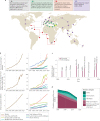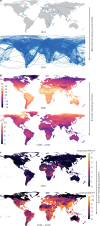Infectious disease in an era of global change
- PMID: 34646006
- PMCID: PMC8513385
- DOI: 10.1038/s41579-021-00639-z
Infectious disease in an era of global change
Abstract
The twenty-first century has witnessed a wave of severe infectious disease outbreaks, not least the COVID-19 pandemic, which has had a devastating impact on lives and livelihoods around the globe. The 2003 severe acute respiratory syndrome coronavirus outbreak, the 2009 swine flu pandemic, the 2012 Middle East respiratory syndrome coronavirus outbreak, the 2013-2016 Ebola virus disease epidemic in West Africa and the 2015 Zika virus disease epidemic all resulted in substantial morbidity and mortality while spreading across borders to infect people in multiple countries. At the same time, the past few decades have ushered in an unprecedented era of technological, demographic and climatic change: airline flights have doubled since 2000, since 2007 more people live in urban areas than rural areas, population numbers continue to climb and climate change presents an escalating threat to society. In this Review, we consider the extent to which these recent global changes have increased the risk of infectious disease outbreaks, even as improved sanitation and access to health care have resulted in considerable progress worldwide.
© 2021. Springer Nature Limited.
Conflict of interest statement
The authors declare no competing interests.
Figures




Similar articles
-
Taking forward a 'One Health' approach for turning the tide against the Middle East respiratory syndrome coronavirus and other zoonotic pathogens with epidemic potential.Int J Infect Dis. 2016 Jun;47:5-9. doi: 10.1016/j.ijid.2016.06.012. Epub 2016 Jun 15. Int J Infect Dis. 2016. PMID: 27321961 Free PMC article.
-
Vaccine development for emerging virulent infectious diseases.Vaccine. 2017 Oct 4;35(41):5437-5443. doi: 10.1016/j.vaccine.2017.02.015. Epub 2017 Feb 16. Vaccine. 2017. PMID: 28216184 Free PMC article.
-
Global health security as it pertains to Zika, Ebola, and COVID-19.Curr Opin Infect Dis. 2021 Oct 1;34(5):401-408. doi: 10.1097/QCO.0000000000000775. Curr Opin Infect Dis. 2021. PMID: 34334661 Review.
-
Commentary: Challenges to Achieve Conceptual Clarity in the Definition of Pandemics.Camb Q Healthc Ethics. 2020 Apr;29(2):218-222. doi: 10.1017/S0963180119001014. Camb Q Healthc Ethics. 2020. PMID: 32159496
-
Scoping future outbreaks: a scoping review on the outbreak prediction of the WHO Blueprint list of priority diseases.BMJ Glob Health. 2021 Sep;6(9):e006623. doi: 10.1136/bmjgh-2021-006623. BMJ Glob Health. 2021. PMID: 34531189 Free PMC article. Review.
Cited by
-
Large-scale genomic analysis of Elizabethkingia anophelis.BMC Genomics. 2024 Oct 29;25(1):1015. doi: 10.1186/s12864-024-10921-y. BMC Genomics. 2024. PMID: 39472795 Free PMC article.
-
A review of risk factors at the human-animal-environmental interface of garbage dumps that are driving current and emerging zoonotic diseases.One Health. 2024 Oct 10;19:100915. doi: 10.1016/j.onehlt.2024.100915. eCollection 2024 Dec. One Health. 2024. PMID: 39468997 Free PMC article. Review.
-
Adrenomedullin as a New Prosperous Biomarker in Infections: Current and Future Perspectives.J Clin Med. 2024 Oct 15;13(20):6142. doi: 10.3390/jcm13206142. J Clin Med. 2024. PMID: 39458091 Free PMC article. Review.
-
Genomics and Bioinformatics in One Health: Transdisciplinary Approaches for Health Promotion and Disease Prevention.Int J Environ Res Public Health. 2024 Oct 9;21(10):1337. doi: 10.3390/ijerph21101337. Int J Environ Res Public Health. 2024. PMID: 39457310 Free PMC article.
-
Spatiotemporal risk of human brucellosis under intensification of livestock keeping based on machine learning techniques in Shaanxi, China.Epidemiol Infect. 2024 Oct 24;152:e132. doi: 10.1017/S0950268824001018. Epidemiol Infect. 2024. PMID: 39444373 Free PMC article.
References
-
- Zhou P, Shi Z-L. SARS-CoV-2 spillover events. Science. 2021;371:120–122. - PubMed
Publication types
MeSH terms
Grants and funding
LinkOut - more resources
Full Text Sources
Other Literature Sources
Medical
Miscellaneous

